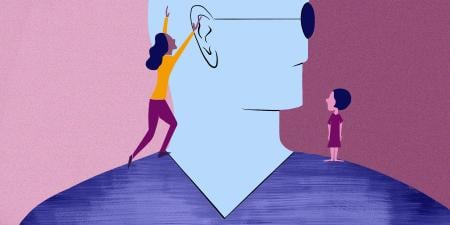False beliefs—those at odds with established bodies of evidence—have a number of origins, including the internet or personal experience. Such beliefs can be held by clinicians as well as patients; in the context of health care, they deserve clinical and ethical attention mainly because they can cause harm. The current preponderance of fake news, persistence of social media as a vehicle to disseminate it, and increasing abundance and easy availability of information—including health-related information—suggest the clinical and ethical importance of focusing on the role of perspective. According to which criteria ought we to evaluate a perspective and regard it as right or wrong? What makes a health care decision a “best” decision? Should personal and professional experiences have authority in decision making even if they are not consistent with clinical practice standards and the body of evidence that supports them? These questions will be explored from clinical, ethical, legal, and cultural perspectives in this issue of the AMA Journal of Ethics.
These cross-disciplinary perspectives offer guidance on how we should think about what constitutes evidence and facts and what kind of authority we grant them. For example, we generally expect members of guideline panels—be they clinical epidemiologists, physicians, researchers, or other professionals—to be capable of interpreting evidence and facts. However, given the same set of data, panel members’ conclusions about best practice recommendations can differ immensely.1 Guideline panels are typically composed of generalists whose views on screening criteria are often more conservative than specialists1-3 because “they have little to gain from the recommendations” and are “chosen for their skills in critical appraisal.”1 In some instances, those who offer recommendations might not be the same professionals who use the guidelines to care for patients. Too often, guidelines use evidence-based data published in high-caliber journals, which we often take for granted as being unbiased though we must learn to critically appraise everything we read.4 This issue is considered by the CMO of the Schwartz Center for Compassionate Healthcare, Beth A. Lown, and general internist Karen E. Victor, in responding to a case in which a physician offers advice based on personal experience and against current guidelines. The authors argue that in such circumstances, physicians should explain their rationale for deviating from clinical guidelines and respect a patient’s autonomy when that patient makes a different treatment decision. Clinicians’ false beliefs are also examined by researcher Elizabeth Boskey and surgeons Amir Taghinia and Oren Ganor. They discuss how health care professionals’ concerns about public accommodation laws intended to protect transgender persons from discrimination can be addressed through analogizing to discriminatory behavior in other contexts.
Two other cases examine a caregiver’s or patient’s false beliefs. Responding to a case of a parent who has false beliefs about her child’s progressing illness, pediatricians Conrad Krawiec and Benjamin Levi show how clinicians can address a parent’s false beliefs by understanding that parent’s perspective, engaging in shared decision making, and, when necessary, reporting neglect. In a third ethical case about a patient with a vegan diet who refuses to take supplements, medical student Elizabeth Southworth and bioethicist Kayhan Parsi argue that taking a food history allows clinicians to provide quality care while respecting patient autonomy, although clinicians need to be honest with patients about the lack of regulation and risks of supplements.
In addition to one-on-one communication between private parties, the internet has emerged as a means for propagating and widely disseminating false beliefs. The need to gather (accurate) information quickly has created a niche for open-access sites like Wikipedia, whose host, the Wikimedia Foundation, has as its mission to contribute to “a world in which every single human being can freely share in the sum of all knowledge.”5 As a student, clinician, researcher, or private citizen with a question, it is tempting and often more efficient to get an answer from sources like Wikipedia rather than using a 2-step authentication process to access a subscription resource. The emergence of readily available information coupled with an abundance of web-based false information prompts the question: Should crowdsourced sources like Wikipedia be used in medical practice and education? Cognitive psychologist Jennifer Meka and medical student Alyssa Vigliotti discuss how medical educators can teach students to appropriately assess and use information from online sources. And health care ethicist Dónal P. O’Mathúna discusses ethical principles that have motivated Wikipedia’s efforts to improve the quality of its content and physicians’ obligations to help patients evaluate online information.
With the emergence of easily accessible information on the internet, one might wonder who should regulate online information and false speech. Public health law expert Joel T. Wu and public policy expert Jennifer B. McCormick not only discuss whether health-related internet-based information should be regulated through constitutional law but also suggest that regulation by government alone is insufficient. Appealing to the American Medical Association (AMA) Code of Medical Ethics, they argue that health care professionals have ethical responsibilities to convey and help their patients obtain accurate health information. And AMA health law editor Scott J. Schweikart argues that false beliefs in medicine can be regulated by the legal doctrines of false speech and professional speech.
Two articles discuss strategies for overcoming patients’ false beliefs. While scientific articles are meant to present unbiased data, they can be difficult for the public to interpret. McCormick discusses her experience as an ethics consultant addressing false beliefs in translational science, especially therapeutic misconception (ie, research participants’ belief that an experimental agent will personally benefit them) by repeatedly engaging participants in discussions of research risks and benefits. And resident physicians Divya Yerramilli and Alexandra Charrow collaborate with bioethicist Arthur Caplan to discuss how celebrity cancer narratives can influence patterns of care; they argue that clinicians should become familiar with these narratives and discuss with patients how they might be influencing their views and decisions.
Finally, 2 contributions highlight the role of visuals in combatting or perpetuating false beliefs. Cardiologist and photographer Joseph Gascho dispels the false belief that physicians do not have time for personal pursuits and self-care by juxtaposing images of physicians wearing white coats with images of physicians engaging in personal pursuits. And AMA archivist Amber Dushman presents images from the AMA Historical Health Fraud and Alternative Medicine Collection that provide insight into medical quackery and how the AMA responded to particular instances of it.
Finally, the podcast highlights what experts in public policy, innovative physician-scientists, and scientific representatives believe are possible avenues to address the dissemination of false beliefs in health care. McCormick and Diane E. Griffin of Johns Hopkins Bloomberg School of Public Health and Albert I. Ko of the Yale School of Public Health will share theoretical, practical, and personal perspectives to address this emerging issue.
We hope that this theme issue provides fresh perspectives on false beliefs in medicine, as technology and crowdsourced online resources that tend to enable their rapid propagation are here to stay. New challenges include ways to appropriately utilize and regulate the vast amount of data and web-based information readily available, which can interfere with patient-physician relationships. This issue highlights how clinicians and educators can address these challenges by striving to form productive alliances with patients and by motivating patients’ and students’ critical thinking about the information they consume to prevent false beliefs’ propagation in communities.
References
- Woolf SH. The price of false beliefs: unrealistic expectations as a contributor to the health care crisis. Ann Fam Med. 2012;10(6):491-494.
- Kahan JP, Park RE, Leape LL, et al. Variations by specialty in physician ratings of the appropriateness and necessity of indications for procedures. Med Care. 1996;34(6):512-523.
- Hutchings A, Raine R. A systematic review of factors affecting the judgments produced by formal consensus development methods in health care. J Health Serv Res Policy. 2006;11(3):172-179.
-
Greenhalgh T, Howick J, Maskrey N. Evidence based medicine: a movement in crisis? BMJ. 2014;348:g3725. doi:10.1136/bmj.g3725.
-
Wikimedia Foundation website. https://wikimediafoundation.org/. Accessed September 21, 2018.



